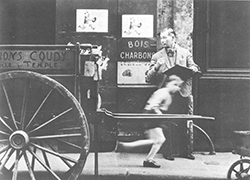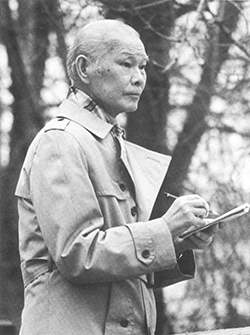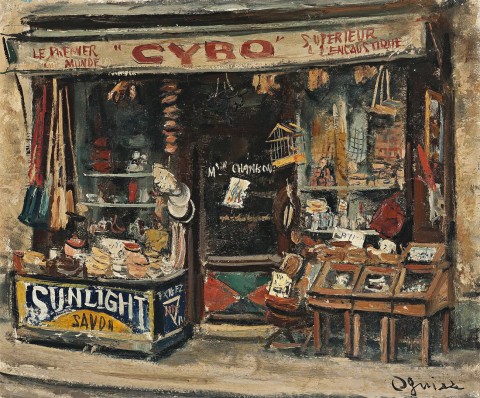MARCHAND DE COULEURS (HARDWARE MERCHANT), c.1931 – 32
TAKANORI OGUISS
oil on canvas
60.0 x 72.0 cm
signed lower right: Oguiss
signed and inscribed with title verso: Marchand / de Couleur / Oguiss / 103 rue de Vaugirard / Paris
Private collection
Leonard Joel, Melbourne, 3 November 1976, lot 208 (as ‘The Shop’)
Private collection, Melbourne
The present owners of the painting met with the artist in Paris, 18 June 1977. He dated the work to c.1931 – 32.
dh190333 (SUPPLEMENTARY IMAGE 2).jpg

In 1927, the young Japanese painter Takanori Oguisu sailed to Paris aboard the brand-new ocean liner SS Athos II, shepherded by his compatriot Saeki Yuzo (who had already made a name for himself in Paris) along with a couple of fellow graduates from the Tokyo School of Fine Arts. He soon settled in a studio in Montparnasse, on Rue Vaugirard, living there from 1927 to 1933, before moving to Montmartre-aux-Artistes, settling on Rue Ordener at the foot of the Butte Montmartre. In very little time he grew accustomed to life as an artist in Paris: presenting annual exhibitions of his paintings in commercial galleries around town and including works in the well-respected Salons d’Automne and des Indépendants, although under a Gallicised moniker – ‘Oguiss’, which he painted in careful cursive in the corners of each picture. Oguiss depicted cityscapes with an unwavering attention to the hidden corners, modest abodes and shopfronts of the ordinary Parisian. He delighted in the imperfections in the surfaces of their architecture, details which bore traces of the lives of many generations – blackened stonework, repainted signs, peeling posters and passing seasons. Nostalgic and romantic, this shopfront view of a Montparnasse hardware and paint store, the Marchand de Couleurs (Hardware Merchant), c.1931 – 32 distils the affective and aesthetic ties which kept the painter’s attention on the City of Light for over sixty years.
While devoid of human presence, the shop is nonetheless bristling with the accumulated traces of human intervention – from the crowded piles of wares stuffed into wooden vitrines and hanging in bunches from the awning, to the encroaching advertisements, hand painted onto wooden panels, fabric banners and enamel signs. Dating this painting to the early 1930s, the angular script of logos for Cybo wax polish and Sunlight soap are clearly legible. With a tightly cropped composition focussed on the cluttered shop’s façade, the Marchand de Couleurs (Hardware Merchant) is reminiscent of another early painting of Paris by Oguiss, La Boutique, 1930 (Private collection). In each painting, the shopfronts are sketched en plein air, with the artist working quickly at an easel on the street, building up the details with nervous and thick painterly daubs and streaks. Marchand de Couleurs (Hardware Merchant), while determinedly focussed on one deserted shop, has a slightly skewed perspective that hints at the winding alleyways of Paris’ arrondissements that dominate Oguiss’ later works.
dh190333 (SUPPLEMENTARY IMAGE 1).jpg

Seeking an authentic and unpretentious visual experience of Paris intra muros, Oguiss followed in the footsteps of the artists of the École de Paris, in particular Maurice de Vlaminck and Maurice Utrillo, settling predictably in the old artist’s quartiers of Montmartre and Montparnasse. This Marchand de Couleurs, one of many hardware stores in these suburbs, certainly supported the local artists, supplying materials to contemporaneous artists such as Chaim Soutine, Chagall, Modigliani and Giacometti. With remarkable foresight, Oguiss devoted his life’s work to a city in flux, committing to memory the scenes of old Paris, of Montparnasse in the twilight years of its artistic heyday. Nowadays almost all of these crumbling and cluttered edifices have disappeared or been carefully dismantled to make way for wide boulevards, shopping centres and apartment complexes. Oguiss has combined the acceptance of impermanence inherent in the Japanese aesthetic of wabi-sabi, with a post-impressionist oil painting technique directly inherited from the émigré artists of the first generation École de Paris. Precious documents of a city now changed, Oguiss’ paintings also bear witness to an era of cultural exchange and the artistic community whose efforts crowned Paris as the epicentre of Modern Art.
LUCIE REEVES-SMITH
